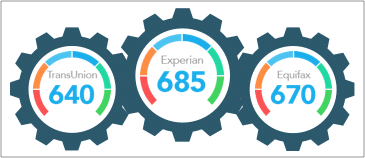Refinancing involves getting a new mortgage with better terms, using it to pay off your old mortgage, and then paying off the new mortgage. Refinancing at the right time and with the right loan can get you a better interest rate and save you a significant amount of money. It can also get you a lower monthly payment, allow you to release a cosigner from their obligations, and even allow you to tap some of your equity in your home.
Refinancing can be a useful tool, but it’s not the right tool for every situation. You will have to assess your options carefully to assure that you’re getting a better deal.
When is the Best Time to Refinance my Home?
In many cases, you can refinance almost immediately after closing your first mortgage. There are a few restrictions, which apply in limited circumstances:
- There may be a waiting period of up to six months after you buy your home before you can consider a cash-out refinance, which taps some equity in your home.
- You will need to wait 210 days before refinancing an FHA loan under the FHA Streamline Refinance program.
- If you have been through loan modification to make your payments more affordable, you may have to wait up to 24 months before refinancing.
Your loan may have a pre-payment penalty, so check if yours have that and what that time period is.
If you are not in one of these positions you can refinance at any time. Some lenders may have their own standards on how soon after your original loan they will consider refinancing.
Whether you want to refinance quickly is another question. Getting a new mortgage involves substantial effort and expense, and you will have to decide whether you will gain enough from refinancing to justify that effort and expense.
What do you Want to Achieve by Refinancing?
There are several possible reasons to refinance:
- Get a better interest rate. If your credit has improved substantially you may be able to get a much lower interest rate on a new mortgage. This will usually take some time after your original mortgage, as credit scores rarely change rapidly.
- Interest rates have dropped. If market interest rates have declined you might be able to get a better rate on a new mortgage. This also usually takes time, as market rates also generally don’t shift quickly and dramatically.
- Shorten your loan’s term. If interest rates have dropped or your credit has improved, you may be able to get a new loan with a shorter term with the same or only slightly higher monthly payments. You will build equity faster and pay your mortgage off sooner.
- Convert an adjustable-rate mortgage to a fixed-rate mortgage. Adjustable-rate mortgages often start out with a low interest rate, but that rate could increase over time. If you have an adjustable-rate mortgage you might refinance with a fixed-rate mortgage to lower your rate and keep it predictable.
- Get a lower monthly payment. If you’ve run into financial difficulties and you’re having trouble making your monthly payments, refinancing with a longer-term loan can lower those payments. Your total interest cost will probably go up with a longer term, even if your interest rate improves, but if your payments are too high you’re in danger of defaulting it could be worth it.
- Remove Private Mortgage Insurance. If your home loan was obtained through the Federal Housing Administration (FHA) you will have to pay for Private Mortgage Insurance (PMI) for the entire loan term if you made little or no down payment. If you have made your loan payments steadily, built up equity, and improved your finances you may qualify for a loan without PMI payments.
- Remove a cosigner or an ex-spouse. Refinancing can release a cosigner from their obligations or remove an ex-spouse from a loan.
- Tap your equity through a cash-out refinance. A cash-out refinance lets you borrow more than you still owe on your home, and can be used if your down payment and subsequent payments have built up equity. This is a way to gain access to a lump sum, but you’ll be left with a larger mortgage balance than you had before. Some borrowers use a cash-out refinance to consolidate higher-interest debt like credit card debt. That can work, but be careful: if you run up more credit card debt you’ll be right back in trouble!
Clarifying your specific personal goals and knowing exactly what you want to accomplish will help you decide whether refinancing is worth the cost and effort. That will help you decide whether it’s the right time to refinance.
How to Shop for a Refinance Loan
Once you know your financial goals, you have to determine whether refinancing will achieve those goals, whether the gains are worth the cost, and whether this is the right time to refinance. You can’t do that effectively until you have specific loan proposals in hand.
Shopping for a mortgage refinance is much like shopping for a mortgage, and you’ll follow the same steps.
- Check your credit and your credit report. Look for errors that could be affecting your credit and issues that you can resolve. The better your credit, the better the terms you’ll get on your new mortgage.
- Assess your income and employment situation. Many lenders prefer to see at least two years of continuous employment. Steady employment and income growth will help you.
- Calculate your debt-to-income ratio (DTI). This is the percentage of your gross monthly income that goes to debt payment. Many lenders won’t consider you a mortgage candidate with a DTI over 43%, and under 36% is better.
- Look for lenders that serve borrowers with your credit profile. Most lenders advertise their credit requirements; if not you can ask.
- Apply with several lenders. Choose a mix of local, national, and online lenders to be sure that you’re getting the broadest possible range of options.
- Be sure to include your own bank or credit union. Your bank knows your track record, and you’ll be able to discuss your application personally with loan officers.
- Make all your applications in a 2-week period. Each application will place a hard inquiry on your credit report. If they are grouped together the credit reporting companies will recognize that you are shopping for a loan and register only a single hard inquiry.
If you are approved for more than one loan, compare the loan offers carefully and select the best one. Look carefully at the interest rates, the fees, and the loan terms. Be sure to read the fine print!
Assess the Costs and Benefits
Once you have a specific proposal in hand you are in a position to determine whether this is the right time to refinance. Compare your loan proposal to your existing loan. You need to determine whether refinancing will achieve your goals at an acceptable cost. You’ll include several factors in that assessment.
- Calculate the cost of your new loan. Most mortgages come with origination fees, which may be a percentage of the loan’s value. This can be a considerable sum. There may be other fees as well.
- If you are refinancing to get a better interest rate you will have to decide whether your savings on interest outweigh the cost of your new mortgage. Calculate a break-even point. Is the new loan really a better deal?
- If you are refinancing with a longer term to get a lower monthly payment, calculate the additional interest cost you will incur from the longer term. Is it worth it?
- Some mortgages come with a prepayment penalty that is imposed if you pay the loan early, or with recapture clauses that allow the lender to recover expenses that they’ve paid on your behalf. If you have these clauses in your mortgage they will affect your cost/benefit calculation.
If you consider these factors and conclude that refinancing will achieve your goals at an acceptable cost, that’s a good sign that it’s the right time to refinance.
If the balance does not look favorable it may be the wrong time to refinance or refinancing might not be the best way to achieve your goals.
The Last Word
In most cases, you can refinance at almost any time after you close your original mortgage. Just because you can refinance doesn’t mean you should. Your financial situation, the length of the mortgage, and the time you’ve held the loan will all factor into whether or not you should refinance your home.
Deciding whether it’s the right time to refinance requires clear goals and a careful assessment of costs and benefits. That assessment will allow you to make a confident decision on whether it’s the right time to refinance your home.




